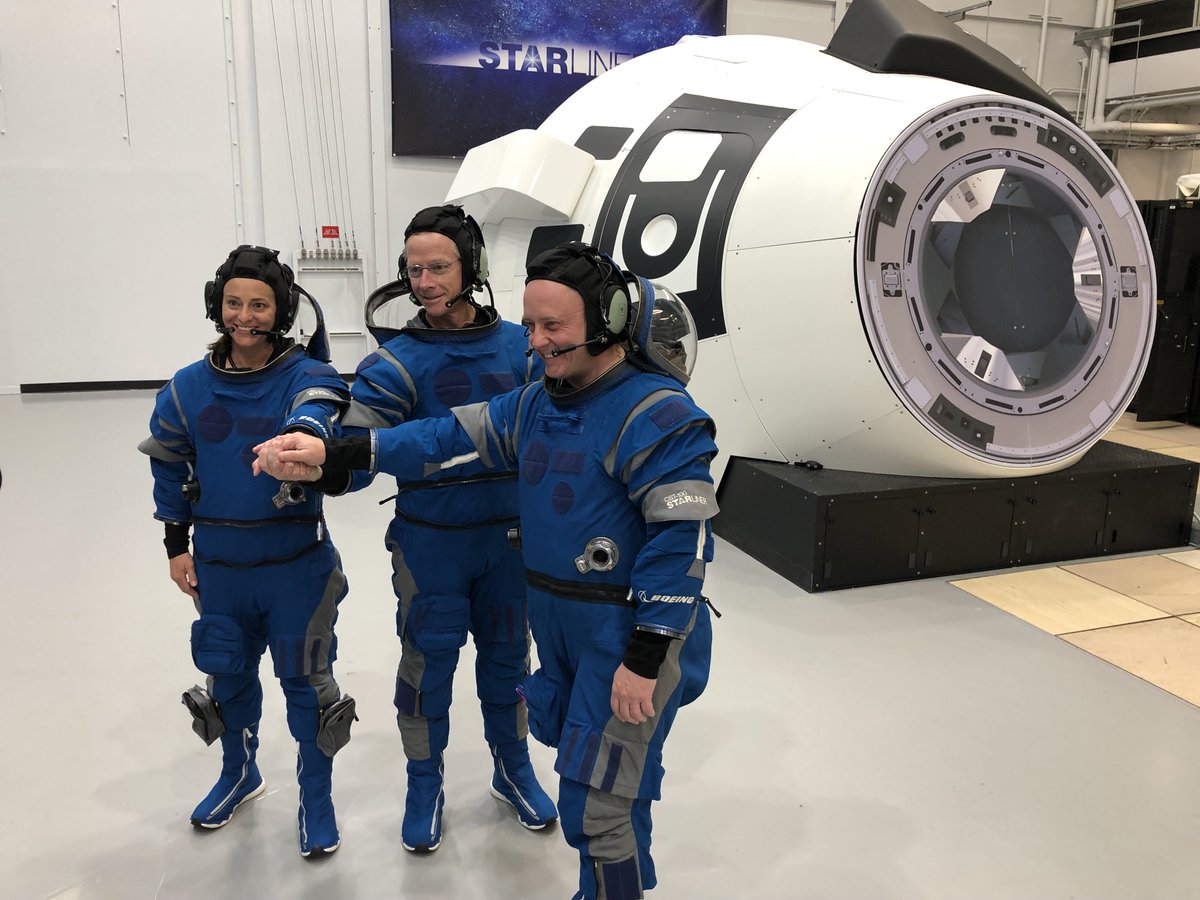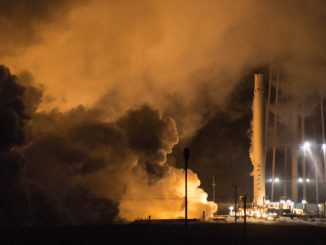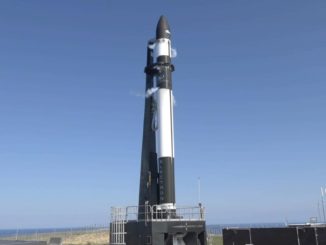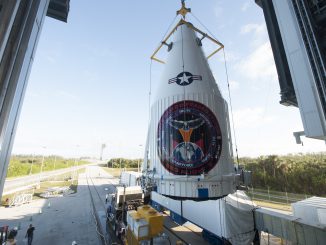
Boeing’s Starliner crew capsule could take off in October on its first unpiloted test flight to the International Space Station, a company official said recently, while SpaceX finishes up the investigation into the explosion of its Crew Dragon spacecraft during a ground test earlier this year.
But schedules for the first crew missions with the new Boeing and SpaceX vehicles remain murky.
NASA and Boeing officials have not announced a target launch date for the Starliner’s first space mission — designated the Orbital Flight Test, or OFT — but officials said the unpiloted test flight is currently on track for liftoff from Cape Canaveral some time in October.
“We’re heading towards an Orbital Flight Test here in October,” said Peter McGrath, director of global sales and marketing for Boeing’s human space exploration program, said Aug. 19. “More than likely, the pad abort test will happen shortly after that, and then we’ll fly the Crew Flight Test vehicle, primarily when NASA’s ready.”
A Boeing spokesperson said Friday that the October timeframe remains the target for launch of the Starliner’s Orbital Flight Test.
The three-flight test sequence will verify the Starliner’s design and operations scheme before NASA approves the Boeing-built capsule for regular crew rotation missions to the International Space Station.
“That’s the one nice thing about crewed flight is we can say we’re ready, but until NASA’s ready, we won’t be flying it,” McGrath said Aug. 19 at the American Institute of Aeronautics and Astronautics’ Propulsion and Energy Forum and Exposition. “These (target schedules) are all based on when they’re safe to fly, not when we’re driving to flight.”
The Orbital Flight Test, the first in the test flight sequence, will take off aboard a United Launch Alliance Atlas 5 rocket from pad 41 at Cape Canaveral. It’s the next launch on ULA’s manifest, following two successful Atlas 5 and Delta 4 rocket launches earlier this month.
The Starliner spacecraft, flying without astronauts on-board, will dock with the space station after launching from Cape Canaveral.
The capsule is scheduled to stay at the station less than a week, then return to an airbag-cushioned landing under parachutes in the Western United States at one of five potential landing sites in New Mexico, Arizona, California and Utah. Boeing has two landing site locations available at the U.S. Army’s White Sands Missile Range in New Mexico, the company’s preferred return site for the Starliner test flights.
The Starliner’s Orbital Flight Test has many of the same objectives of SpaceX’s first Crew Dragon demonstration flight to the station in March.
NASA awarded contracts in 2014 to Boeing and SpaceX — valued at $4.2 billion and $2.6 billion, respectively — for the development of new U.S.-built commercial crew ships to ferry astronauts to and from the space station, ending U.S. reliance on Russian Soyuz vehicles for the task.

White Sands will also host the Starliner pad abort test, in which Boeing engineers will demonstrate the spacecraft’s ability to escape an emergency on the launch pad. The Starliner has four liquid-fueled launch abort engines clustered on the bottom of the craft to push the capsule off its launcher, giving crews an escape switch before and during liftoff.
Boeing’s pad abort test at White Sands is a critical precursor to the Starliner’s first piloted mission, which will carry Boeing test pilot and former NASA space shuttle commander Chris Ferguson, and NASA crew members Mike Fincke and Nicole Mann to the space station.
After launching some time late this year or in early 2020, Ferguson, Fincke and Mann will live on the station for up to six months before returning to Earth in their Starliner spacecraft to complete the program’s Crew Flight Test, or CFT. Assuming the test flights go well, NASA will certify the Starliner for operational crew rotation flights to the station.
“This is going to be an exciting end of the year with a lot of activity going for us,” McGrath said. “We are flying a true operational vehicle up to station for our test flight coming up in October. That vehicle will be refurbished and used on the first crew flight mission (after the Crew Test Flight), so it is a full flight article.
“We test like we fly,” McGrath said. “So what you’re seeing (on the first test flight) is the real thing of what we will fly crew on.”
With the Aug. 8 launch of a U.S. Air Force communications satellite now behind them, ULA teams are ready to stack the Atlas 5 rocket for the Starliner’s first test flight in the coming weeks inside the Vertical Integration Facility at pad 41.
Ground crews will first erect the Atlas 5’s bronze core stage, powered by a Russian-made RD-180 main engine, then install two Aerojet Rocketdyne-built solid rocket boosters to the vehicle. A Centaur upper stage fitted with two Aerojet Rocketdyne RL10 engines will be hoisted atop the Atlas 5 before the Starliner crew capsule arrives at the launch pad integration building.
The Atlas 5 configuration designed for Boeing’s Starliner crew capsule features several changes from earlier Atlas 5 models. The modifications include the dual-engine Centaur stage, an independent avionics package to detect an in-flight emergency and trigger an abort, and a new aerodynamic shape without a payload shroud at the top of the launcher.
#Starliner’s Service Module is weighing in to determine its center of gravity measurements before flight. That’s to ensure it’s up to its two essential tasks – executing in-space maneuvers to @Space_Station or providing a safe escape if there’s an emergency on launch day. pic.twitter.com/pVm1ySQ1E4
— Boeing Space (@BoeingSpace) August 23, 2019
According to ULA, the Atlas 5 will release the Starliner spacecraft on a 112-mile-high (181-kilometer) suborbital trajectory, just shy of the velocity needed to enter a stable orbit around Earth. After separating from the rocket, the Starliner’s own engines, mounted on the ship’s service module, will boost the spacecraft into orbit to begin the trek to the International Space Station.
The suborbital trajectory is unusual for a satellite launch, but it is similar to the technique used by the space shuttle. The shuttle’s three main engines, fed by cryogenic propellants from an external fuel tank, accelerated the orbiter into space to a speed just shy of the velocity required to enter orbit.
After jettisoning the expendable external tank, the shuttles fired their in-space maneuvering engines around a half-hour after launch to enter orbit. Otherwise, the shuttles would have cut short their missions and re-entered the atmosphere.
The Starliner will follow a similar launch profile.
“The Atlas 5 is flying a very unique trajectory for us,” said Josh Barrett, a Boeing spokesperson. “ULA usually flies the Atlas 5 on a steep trajectory to use the powerful booster engine and any added solids to gain as much altitude as quickly as possible before leveling off and then letting the incredibly efficient Centaur push the rest of the way to the desired orbit.
“With Starliner, the Atlas 5 is flying a much flatter and throttled back trajectory for two main reasons,” Barrett said in response to questions from Spaceflight Now. “The first is if we abort on a steep trajectory, we would have the potential to bounce off the atmosphere, so this trajectory allows a safe abort at every point through ascent. The second is it helps keep g-loading on crew members to a minimum on ascent.”
Starliner crews will experience forces up to 3.5 Gs on launch, according to Boeing officials.
Barrett said Boeing does not publicly disclose mass numbers for the Starliner spacecraft. SpaceX also did not provide the launch weight for the Crew Dragon spacecraft during its first test flight to the space station in March.
Mass figures — either exact or approximate — for most commercial satellites and human spaceflight vehicles are typically released by their owners or by government agencies.

SpaceX, meanwhile, is wrapping up an investigation into the explosion of a Crew Dragon test vehicle during a ground test April 20 at Cape Canaveral Air Force Station.
The explosion occurred moments before a static fire test of the Crew Dragon’s SuperDraco abort engines, which would be activated to save astronauts from a launch failure. No one was hurt in the explosion, but SpaceX’s first space-worthy Crew Dragon capsule was destroyed in the accident, weeks after returning to Earth from a six-day mission to the space station.
When the explosion happened, SpaceX engineers were readying the Crew Dragon spacecraft for a second flight to test the SuperDraco launch escape system’s capability for an in-flight abort from a Falcon 9 rocket.
Engineers believe a leak of propellant inside the Crew Dragon spacecraft’s propulsion system led to the capsule’s explosion. Hans Koenigsmann, SpaceX’s vice president of build and flight reliability, said last month that engineers are replacing valves inside the Crew Dragon’s launch abort propulsion system to prevent similar leaks from happening in the future.
During the April 20 test, a leaky check valve inside the propulsion system allowed nitrogen tetroxide oxidizer, which the Crew Dragon’s eight SuperDraco rocket engines consume mixed with hydrazine fuel, to enter high-pressure helium tubes during ground processing, SpaceX said last month in a briefing with reporters.
The helium system is used to quickly pressurize the propulsion system, allowing the SuperDraco thrusters to fire up during a launch emergency and push the Crew Dragon and its astronaut crew away from a failing rocket. Investigators believe the pressurization sequence forced the nitrogen tetroxide that leaked into the helium system back into the check valve, destroying it and triggering an explosion.
Koenigsmann said Aug. 19 that SpaceX engineers did not expect any problems with the Crew Dragon propulsion system. Hydrazine and nitrogen tetroxide are propellants commonly used on a variety of spacecraft, including the space shuttle and Boeing’s Starliner.
“We found something that is … I don’t want to say a new vulnerability, but it is something we have to be careful about,” Koenigsmann said.
“We have a bunch of corrective actions that we will work prior to the first (crew) flight,” he said.

“Overall, we’re almost ready to tie a bow around it (the investigation),” Koenigsmann said. “We need a couple more lines of the fault tree that we need to to run down. It’s very systematic. It’s a slow process, but overall I’m confident we’ll get this over with before the next month, basically.”
Koenigsmann gave no indication that SpaceX has changed its conclusion that a faulty valve led to the Crew Dragon test accident.
With the first space-rated Crew Dragon destroyed, SpaceX will fly the next Crew Dragon spacecraft off the company’s assembly line for the in-flight abort test. That particular capsule was originally assigned to launch on the Demo-2 mission, SpaceX’s first flight with astronauts.
NASA astronauts Bob Behnken and Doug Hurley are training for the first piloted Crew Dragon test flight.
“We have the in-flight abort test coming up, too,” Koenigsmann said. “That’s supposed to be in the October/November timeframe, and then right after that, hopefully this year, we have the Demo-2 flight coming up.”
Email the author.
Follow Stephen Clark on Twitter: @StephenClark1.



